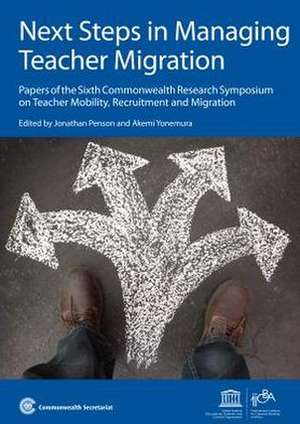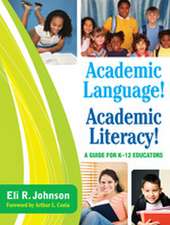Next Steps in Managing Teacher Migration: Papers of the Sixth Commonwealth Research Symposium on Teacher Mobility, Recruitment and Migration
Editat de Jonathan Penson, Akemi Yonemuraen Limba Engleză Paperback – 31 oct 2012
Preț: 442.54 lei
Preț vechi: 520.64 lei
-15% Nou
Puncte Express: 664
Preț estimativ în valută:
84.68€ • 88.41$ • 70.08£
84.68€ • 88.41$ • 70.08£
Carte disponibilă
Livrare economică 15-29 martie
Livrare express 01-07 martie pentru 35.20 lei
Preluare comenzi: 021 569.72.76
Specificații
ISBN-13: 9781849290777
ISBN-10: 1849290776
Pagini: 180
Dimensiuni: 208 x 295 x 13 mm
Greutate: 0.64 kg
Ediția:New.
Editura: COMMONWEALTH SECRETARIAT
ISBN-10: 1849290776
Pagini: 180
Dimensiuni: 208 x 295 x 13 mm
Greutate: 0.64 kg
Ediția:New.
Editura: COMMONWEALTH SECRETARIAT
Notă biografică
Jonathan Penson is Adviser (Education) in the Social Transformation Programmes Division at the Commonwealth Secretariat. Akemi Yonemura is Program Specialist at UNESCO-IICBA.
Cuprins
Dedication; Foreword; Acknowledgements; Abbreviations and acronyms; 1. Introduction, Jonathan Penson and Akemi Yonemura; PART I. MANAGING TEACHER RECRUITMENT AND MIGRATION; 2. Migration and development: Key issues for consideration for the Commonwealth, Constance Vigilance; 2.1 Introduction; 2.2 Recent trends; 2.3 Key topics and concepts; 2.4 Engagement of international institutions on migration and development; 2.5 The way forward; 3. Towards a global response to teacher preparation, recruitment and migration, Michael Omolewa; 3.1 Introduction; 3.2 Topical questions; 3.3 The UNESCO initiative; 3.4 The Commonwealth initiative; 3.5 Negotiated consensus; 3.6 Conclusion; 4. Revisiting the implementation of the Commonwealth Teacher Recruitment Protocol: Furthering implementation and addressing critical steps in the recruitment process, Kimberly Ochs; 4.1 Introduction; 4.2 Revisiting the issue of teacher migration; 4.3 The system of teacher mobility; 4.4 Protocol dissemination; 4.5 Revisiting protocol dissemination and implementation; 4.6 The central importance of context; 4.7 Discussion and conclusions; 4.8 Recommendations; 5. A continental teacher recruitment protocol in Africa: Key considerations from the Commonwealth Teacher Recruitment Protocol, James Keevy; 5.1 Introduction; 5.2 Learning from the experiences of the Commonwealth Teacher Recruitment Protocol; 5.3 The meaning of an African approach: policy learning and an African philosophy; 5.4 Thoughts on the proposed African Continental Teacher Recruitment Protocol; 5.5 Concluding comments; PART II. APPLICATION OF CTRP PRINCIPLES: EXPERIENCES FROM THE FIELD AND GOOD PRACTICES; 6. Managing teacher recruitment and migration: A case study of the Barbados experience, Roderick Ricardo Rudder; 6.1 Introduction and background; 6.2 Methodology; 6.3 Discussion of findings; 6.4 Conclusions; 7. Teacher migration and the role of historically black colleges and universities and Hispanic serving institutions in the United States, Helen Bond; 7.1 Commonwealth Teacher Recruitment Protocol; 7.2 Root causes of teacher shortages; 7.3 Prince George's County public schools; 7.4 Minority teacher investment; 7.5 HBCUs and HSIs and teacher migration; 7.6 Ready to Teach programme; 7.7 Conclusion and recommendations; 8. The need for teachers: An Ethiopian case study, Theodros Shewarget, Theresa Wolde-Yohannes and Akemi Yonemura; 8.1 Introduction; 8.2 The purpose of this paper; 8.3 Background and educational context; 8.4 Research questions; 8.5 Methodology; 8.6 Findings; 8.7 Analysis; 8.8 Conclusion; 9. Zimbabwean education professionals in South Africa: Motives for migration, Sadhana Manik; 9.1 Introduction; 9.2 Literature review; 9.3 Methodology of study; 9.4 Findings of study; 9.5 Discussion and conclusion; PART III. TEACHER MIGRATION: REMAINING ISSUES TO CONSIDER; 10. Where have all the teachers gone? Why there are never any teachers in Africa's refugee camps and what we can do about it, Barry Sesnan; 10.1 Introduction; 10.2 Creation of a teaching force in an emergency or the short term; 11. Teacher migration and education in conflict and post-conflict countries: Experience from Somalia, Christophe Mononye; 11.1 Introduction; 11.2 Teacher migration (context-specific) and its implications; 11.3 Challenges; 11.4 Summing and conclusion; 12. Teacher attrition in Wolaita: The cases of domestic migration of Bolosso Sore and Damot Gale woredas, Michael Daniel Ambatchew; 12.1 General background; 12.2 Statement of the problem; 12.3 Literature review and theoretical framework; 12.4 Aims; 12.5 Methodology; 12.6 Findings and discussion; 12.7 Limitations; 12.8 Conclusion and recommendations; 13. Challenges facing higher education in the Southern African Development Community, Louis J van der Westhuizen; 13.1 Introduction; 13.2 SADC contents; 13.3 Levels of higher education quality assurance development in SADC; 13.4 Quality assurance initiatives; 13.5 Staff capacity as a factor influencing the potential of higher education; 13.6 Challenges facing the SADC higher education institutions; 13.7 The way forward; PART IV. NEXT STEPS IN MANAGING TEACHER MIGRATION; 14. Beyond the Commonwealth Teacher Recruitment Protocol: Next steps in managing teacher migration in education in emergencies, Jonathan Penson, Akemi Yonemura, Barry Sesnan, Kimberly Ochs and Casmir Chanda; 14.1 Introduction; 14.2 Background; 14.3 Definition of terms; 14.4 Situational analysis; 14.5 Literature review and analysis; 14.6 Case study: refugees from South Sudan; 14.7 The principles of the Commonwealth Teacher Recruitment Protocol and emergencies; 14.8 Recommendations; 14.9 Conclusion; Monitoring form













